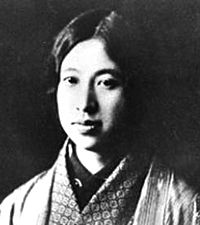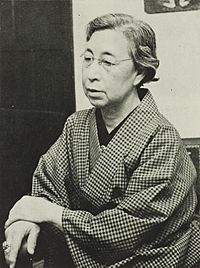Hiratsuka Raichō facts for kids
Quick facts for kids
Hiratsuka Raichō
|
|
|---|---|

Raichō, from her autobiography
|
|
| Born | Haru Hiratsuka February 10, 1886 Tokyo, Japan |
| Died | May 24, 1971 (aged 85) |
| Nationality | Japanese |
Hiratsuka Raichō (平塚 らいちょう, transliterated らいてう according to the historical kana orthography, February 10, 1886 – May 24, 1971) was a writer, journalist, political activist, anarchist and pioneering Japanese feminist.
Life
Born Hiratsuka Haru (平塚 明) in Tokyo in 1886, the second daughter of a high ranking civil servant, and educated at Japan Women's University (日本女子大学) in 1903, Hiratsuka came to be influenced by contemporary currents of European philosophy, as well as Zen Buddhism, of which she would become a devoted practitioner. Of particular influence to her was turn-of-the-century Swedish feminist writer Ellen Key, some of whose works she translated into Japanese, and the individualistic heroine of Henrik Ibsen's A Doll's House (1879).
Upon graduation from university, Hiratsuka entered the Narumi Women's English School where, in 1911, she founded Japan's first all-women literary magazine, Seitō (青鞜, literally Bluestocking). She began the first issue with the words, "In the beginning, woman was the sun" (「元始、女性は太陽であった」) – a reference to the Shinto goddess Amaterasu, and to the spiritual independence which women had lost. Adopting the pen name "Raichō" ("Thunderbird"), she began to call for a women's spiritual revolution, and within its first few years the journal's focus shifted from literature to women's issues. Contributors included renowned poet and women's rights proponent Yosano Akiko, among others.
Even though many Japanese became exposed to the ideas of the modern feminist, due to rebuttals of Japan's media, most did not take their ideas serious, thinking that Raichō and her comrades were attempting to steal a moment of fame in history. Exaggerated stories of their love affairs and nonconformism, once again spread by Japan's mainstream press, turned public opinion against the magazine and prompted Raichō to publish several fierce defenses of her ideals. Her April 1913 essay "To the Women of the World" (「世の婦人たちに」) rejected the conventional role of women as ryōsai kenbo (良妻賢母, Good wife and wise mother): "I wonder how many women have, for the sake of financial security in their lives, entered into loveless marriages to become one man's lifelong servant." This nonconformism pitted Seitō not only against the society but the state, contributing to the censorship of women's magazines that "disturbed public order" or introduced "Western ideas about women" incompatible with Japan.
The journal folded in 1915, but not before establishing its founder as a leading light in Japan's women's movement. Meanwhile, in 1914, Hiratsuka began living openly with her younger lover, artist Okumura Hiroshi, with whom she had two children out of wedlock and eventually married in 1941.
From 1918 to 1919, Akiko Yosano started to claim the importance of women's financial independence in the context of rapid development of capitalism in Japan after the end of World War I. Since Hiratsuka were influenced by Key's argument of the priority of motherhood through the translation of her works, she claimed that complete independence is an impractical expectation in the situation at that time, and added maternity protection with financial assistance by the government is necessary to establish women's national, social existence in the context of the difficult condition of women's workers, against Yosano's argument. Afterwards, Yamakawa Kikue and Yamada Waka participated in this debate, and it became a big social movement known as Maternity Protection Controversy (母性保護論争, Bosei-hogo ronso).
In 1920, following an investigation into female workers' conditions in textile factories in Nagoya which further galvanized her political resolve, Hiratsuka founded the New Women's Association (新婦人協会, Shin-fujin kyokai) together with fellow women's rights activist Ichikawa Fusae. It was largely through this group's efforts that the Article 5 of the Police Security Regulations—which, enacted in 1900, had barred women from joining political organizations and holding or attending political meetings—was overturned in 1922. Women's suffrage, however, remained elusive in Japan.
Hiratsuka would join the cooperative movement in the 1930's, concluding that this would be the best option to include the most amount of people towards the main goal of social reform. The next several years, however, saw Hiratsuka withdraw somewhat from the public eye, saddled with debts and her lover beset with health problems, although she would continue to write and lecture. In the postwar years, she emerged again as a public figure through the peace movement. In 1950, the day after the outbreak of the Korean War, she traveled to the United States together with writer and activist Nogami Yaeko and three other members of the Japan Women's Movement (婦人運動家) in order to present US Secretary of State Dean Acheson with a request that a system be created in which Japan could remain neutral and pacifist. Hiratsuka continued to champion women's rights in the postwar era, founding the New Japan Women's Association (新日本婦人の会) in 1963 together with Nogami and noted artist Iwasaki Chihiro, and continuing to write and lecture up until her death in 1971.
Legacy
While her career as a political activist covered many decades, Hiratsuka is primarily remembered for her stewardship of the Seitō group. As a leading light of the women's movement in early twentieth century Japan, she was a highly influential figure whose devotees ranged from pioneering Korean feminist author Na Hye-sok (나혜석; 羅蕙錫) who was a student in Tokyo during Seitō's heyday to anarchist and social critic Itō Noe whose membership in the Seitō organization generated some controversy. Her postwar organization, the New Japan Women's Organization, remains active to this day.
Selected works
Original works
- 『円窓より』 (Marumado yori, The View from the Round Window)
- 『元始、女性は太陽であった』 (Genshi, josei wa taiyō de atta, In The Beginning Woman Was The Sun)
- 『私の歩いた道』 (Watakushi no aruita michi, The Road I Walked)
Translations
- Ellen Karolina Key, The Renaissance of Motherhood (『母性の復興』, Bosei no fukkō)
- Ellen Karolina Key, Love and Marriage (『愛と結婚』, Ai to kekkon)
- Teruko Craig, In the Beginning, Woman Was the Sun – The Autobiography of a Japanese Feminist(『元始、女性は太陽であった』, Genshi, josei wa taiyō de atta)
See also
 In Spanish: Raichō Hiratsuka para niños
In Spanish: Raichō Hiratsuka para niños


